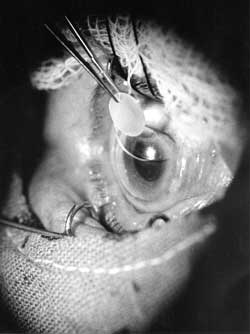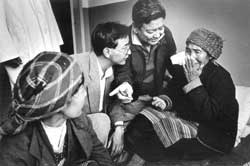Twenty years ago, if Nepalis developed cataracts most either went blind or went to India for treatment. Today, the scene is reversed: thousands of Indian patients with cataracts and other eye disease come to specialised centres in Nepal
for treatment.
It is one of those little-known success stories of Nepal's development in the past 20 years that the country is now a regional leader in eye care. In 1981, there was only one eye hospital in Nepal, today there are 17 hospitals and 32 other eye care centres. In addition, six government hospitals have full-fledged ophthalmologic departments. While doctors are still in short supply, there are 85 eye doctors for Nepal's 23 million population, there are 175 trained ophthalmic assistants, 335 specialised eye care paramedics.
While impressive, these numbers still do not meet the colossal need for eye care in Nepal. Like most developing countries in the region, the prevalence of blindness is quite high. (Nepal .8 percent, India .7 percent, Myanmar .9 percent, Bangladesh 1, Sri Lanka .5 percent): children often suffer eye infections which can easily be cured but due to lack of antibiotics many children go blind. Cataract is still common, and despite impressive strides to control it blindness due to vitamin A deficiency still exists.
A National Blindness Survey in 1981 found that 80 percent of the blind suffered from preventable or curable blindness, cataract, trachoma and glaucoma as the three leading causes of blindness. The survey was a landmark exercise in the developing world, and clearly identified the inaccessibility of eye care services as a major problem in the Third World. To improve accessibility to eye-care, zonal eye hospitals were set up in the 1980s to first establish the necessary infrastructure. It was only after 1990 that attention was given to enhancing the quality of services. Now, the government has launched an ambitious Vision 2020 programme-part of a global drive against avoidable blindness. Under the programme, Nepal is obliged to train ophthalmologists and provide surgical supplies to eliminate leading eye diseases like cataract, trachoma, childhood blindness and other eye diseases.
But to meet that goal, we need to produce 400 more ophthalmologists and four times more supporting staff and technicians in the next 15 years. Today, Nepal produces only an average of five eye specialists a year. The national drive against cataract, the leading cause of blindness in Nepal and the world, paid attention to the number of surgical procedures and overlooked the quality. The same national survey found that the conventional type of cataract surgery where the cataract was removed and patients were given very thick glasses-half were not actually wearing their glasses and were thereby functionally blind. Owing to the lack of proper modern equipment cataract surgical related complications were very high..
As an answer to the problem, Tilganga Eye Centre (TEC) started an intraocular lens production lab in 1994 with assistance from the Fred Hollows Foundation of Australia. The laboratory is now run by an all-Nepali team to produce world standard intraocular lenses to be used within Nepal and to be exported to southeast Asia.
The Fred Hollows Foundation was set up to carry on the work of Australian visionary Prof Fred Hollows who thought it was appalling that people in the developing world go blind from cataracts because they didn't have access to affordable treatment. He set out to provide local doctors in these countries, with the skills and tools they needed to give people back
their sight.
One such doctor, Sanduk Ruit, Medical Director of the Nepal Eye Program (synonymous with Tilganga Eye Centre) pioneered the modern cataract surgery: removing only the clouded lens and implanting an intraocular lens into the natural capsule.
"With this method the sight of an eye can be restored near to the normal level," says Ruit whose team proved that modern cataract surgery can be done safely and hygienically in developing countries like Nepal, Eritrea, Vietnam, China and Myanmar with results equal to those obtained in Australia and throughout the world.
Ruit is driven by a dream to have a self-sustaining eye care program throughout Nepal. TEC stresses a strict pricing tier, cross subsidies and high quality care. "A barefoot patient coming from Sindhupalchowk and a member of Parliament get the same treatment," says Ruit who as a general medical doctor attending an eye camp in western Nepal was intrigued by the problem of blindness.
"Opthalmology is a high tech branch of medicine, advancing very quickly. At the Centre, we try to adapt the latest technology but still keep our feet on the ground, keeping Nepali conditions in mind."
Today, TEC runs a grief-counselling centre and an eye bank for cornea donations. About 30 percent of patients receive free treatment, 50 percent are paying patients, and the rest are subsidised. It has started outreach centres in Ramechap and Dhading where eye health care facilities are lacking.
The production of intraocular lenses was a turning point for Nepal's fight against cataract blindness. TEC produces 100,000 one-piece lenses a year for just Rs 450 (about $6) each, whereas the same quality lens costs $150 in Australia. Presently, 95 percent of cataract operations are completed with implantation of intraocular lens. In neighbouring India and Bangladesh, the percentage is only 50 and 35 respectively.
What is the reason for this remarkable success story? Dr Ram Prasad Pokharel, pioneer eye care activist in Nepal, has no doubt about the reason: "Non-interference from the government allowed the sector to explore the development potentiality to the fullest." Pokharel's Nepal Netra Jyoti Sangh (NNJS) is now also offering its eye care expertise to patients outside Nepal.
Major eye-care institutions in the country like Til Ganga and Netra Jyoti are non-governmental entities and run 16 zonal hospitals. These institutions have been successful in maximising cost effectiveness of donors funds and instead of depending on sale of expensive services to richer clients they have targeted attracting a large turnover to reduce the price for eye treatment.
The economy of scale means that corrective eye-surgery in Nepal can cost between Rs 2,000-Rs 6,000, whereas a similar surgery in New Delhi can cost between Rs 20,000-Rs 40,000. The reason the treatment is better and cheaper here is the efficiency of Nepali ophthalmologists. According to an unofficial evaluation, the number of cataract surgeries performed by an ophthalmologist per year in Nepal is 1,062, while it is about 300 in India and 150 at the ophthalmologic department at the government-run TU Teaching Hospital in Kathmandu.
Impressive as these achievements are, the distribution of eye care centres in Nepal is still uneven. The Central Development Region where Kathmandu is situated has seven full-fledged eye hospitals, while rest of the country is left with ten hospitals. Similarly out of the 17 hospitals, more than half are in the tarai, while the high mountain belt does not have a single hospital.
The high concentration of eye-care institutions in the tarai have put Nepalis at a disadvantage because the hospitals are swamped with patients from northern Bihar and Uttar Pradesh across the border. In a country where health awareness and the concept of consulting doctors are unfamiliar, Indian patients are usually taking advantage of the inexpensive and high quality services available in Nepal. Lahan Eye Hospital and Lumbini Eye Hospital, centres of excellence, serve locals as well as Indian patients from Bihar and UP. Data show that of the 80,000 cataract operations conducted in Nepali eye hospitals last year, 70 percent were on Indian patients. This trend has over-burdened hospitals near the Indian border. Last year, Lahan Eye Hospital, one of the most popular with Indian patients conducted 28,835 cataract operations with its five ophthalmologists.
"Unless all the hospitals run outreach programmes, poorer Nepalis are not going to benefit much," said Nabin Kumar Rai, Medical Coordinator of Tilganga Eye Centre. TEC conducted half of its 7,300 cataract surgeries at mobile eye camps last year. Nepal Netra Jyoti Sangh (NNJS) sources said that only 40 percent of the people who get care are served by hospitals at present, while the rest are treated at free mobile eye camps conducted by various organisations. The researchers also found that word of mouth was the main source of information for 80 percent of these patients who eventually got treatment.

Dr Sanduk Ruit of the Nepal Eye Program pioneered modern cataract surgery removing only the clouded lens and implanting an intraocular lens into the natural capsule. This technique is now used by Nepali doctors to restore sight to thousands of blind patients from Eritrea to Cambodia

Dr Ruit (second from right) speaks to a Tibetan cataract patient in Lhasa through an interpreter.


